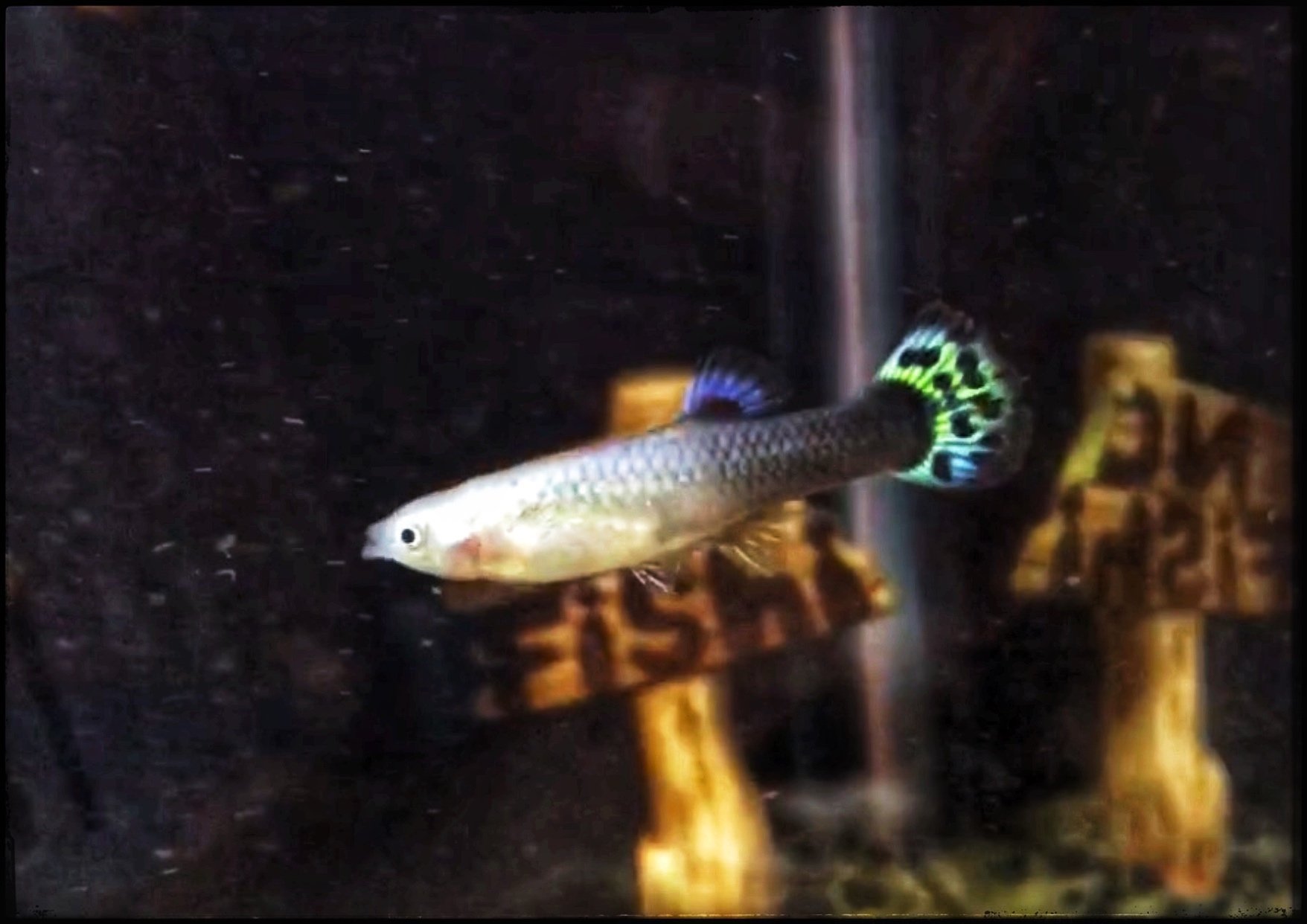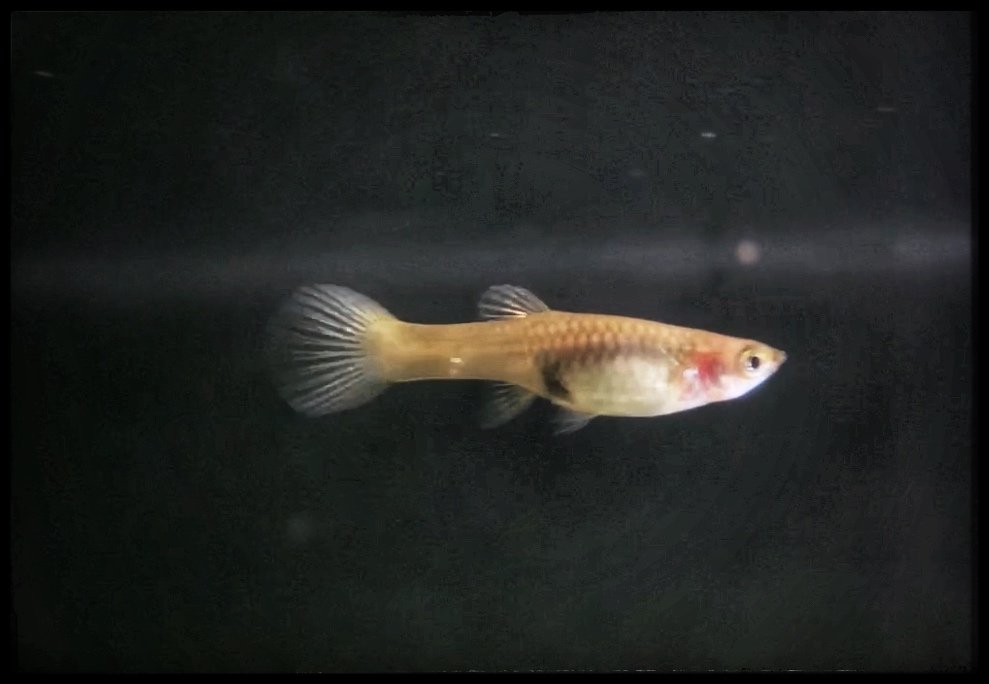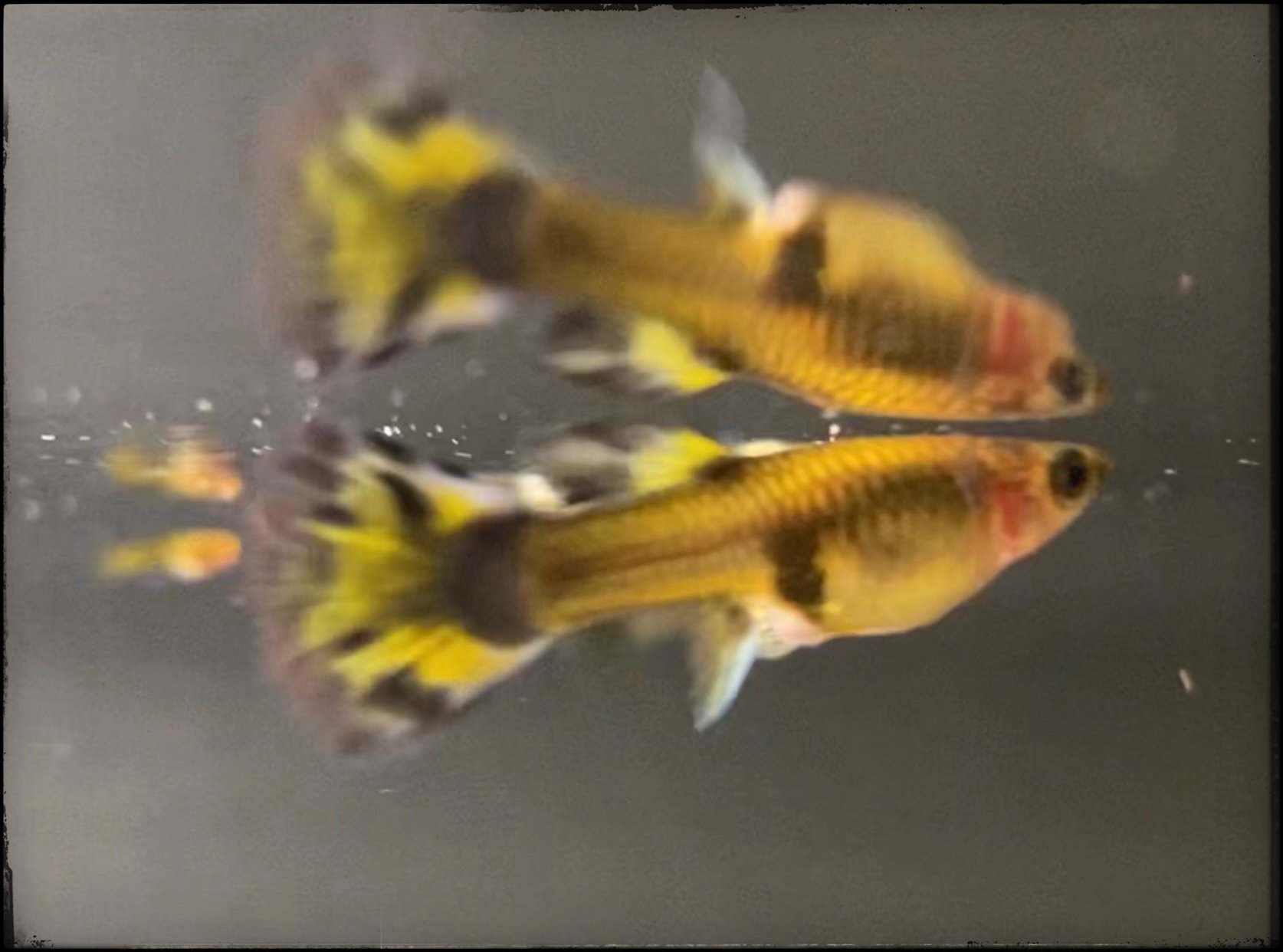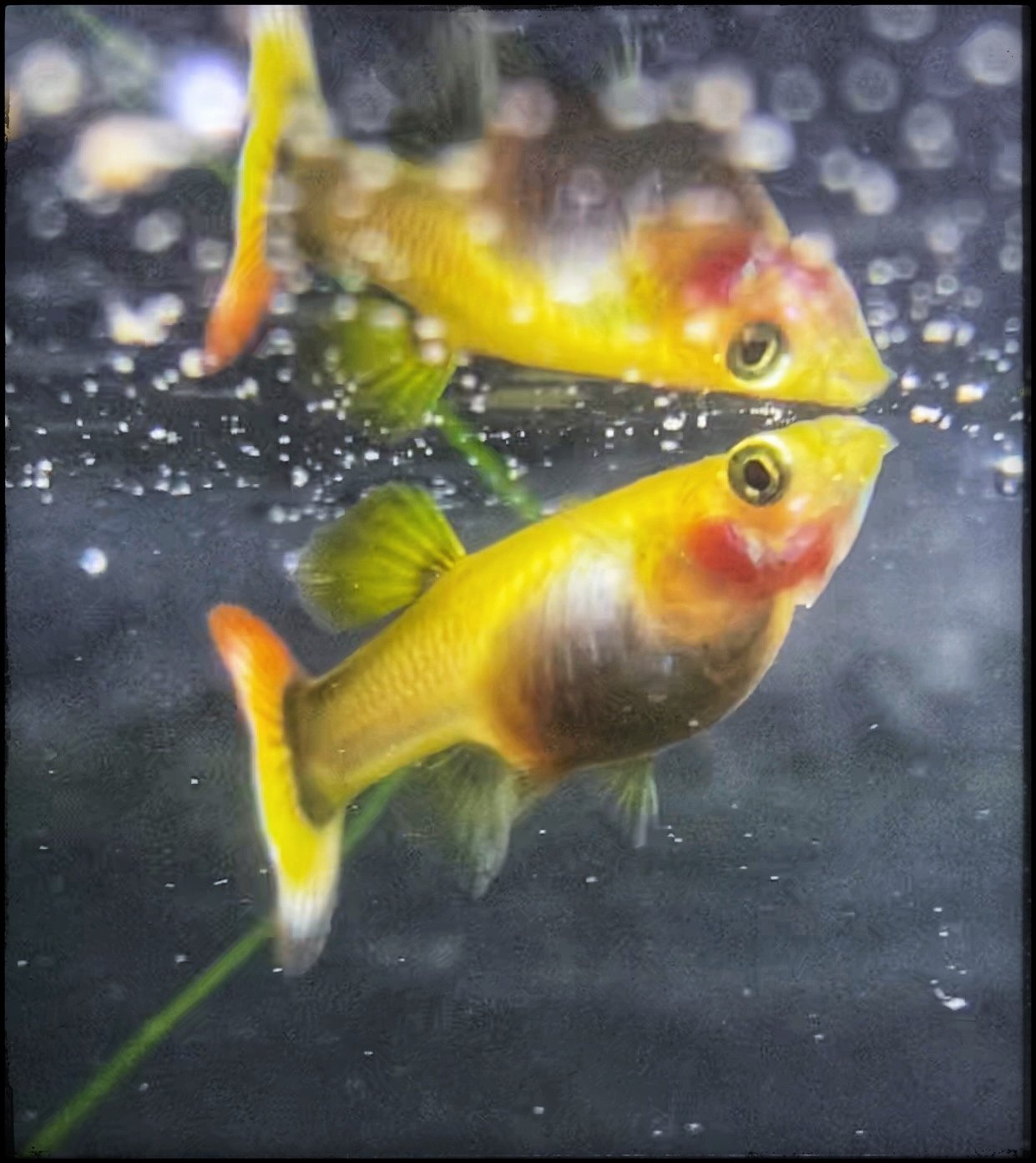Expanded Fish Care
guppy fish/ endler
Fancy Guppy
Kingdom: Animalia
Phylum: Chordata
Class: Actinopterygii
Order: Cyprinodontiformes
Family: Poeciliidae
Genus: Poecilia
Species: Poecilia reticulata
Endler Guppy
Kingdom: Animalia
Phylum: Chordata
Class: Actinopterygii
Order: Cyprinodontiformes
Family: Poeciliidae
Genus: Poecilia
Species: Poecilia wingei
Care level-Easy to Expert
Temperament and Behavior- Peaceful & Active
Lifespan- 1-3 years- After researching Guppies, I have read that Guppies and Endlers can potentially live up to 5 years in ideal conditions. In my fish room, my Guppies live on average three years. Also, it does seem that the females in my fish room typically outlive the males.
Size- 1-3 inches
Diet- Omnivores
Fancy Guppy Fish, like Endlers, are omnivores and require both plant and animal proteins in their diet. Feeding a variety is key to keeping a healthy diet. Offering flakes once a day will suffice but keeping a beautiful, robust Guppy tank, the secret is feeding foods that will meet their needs. Plant proteins found in veggie pellets or rounds are often a hit. Flake food is a staple of the fish room. However, buy a few different kinds: my two favorites are Tetra Flakes and Xtreme Krill Flakes. Also, when feeding Guppies and Endler's frozen foods, reserve it for a once-a-week treat. They enjoy bloodworms and baby brine shrimp; however, the baby brine shrimp are more manageable for them to eat. I offer Fluval Bug Bites containing mosquito lava as a good alternative. When feeding, remember, do not overfeed; only provide what they can eat. Offering smaller portions of food throughout the day works best. Do what works for you; however, monitor that no food is left.
Minimum Tank Size- 5-10 gallons- There are countless reasons why Guppies are a highly recommended fish. However, one of those reasons is their stature. Being smaller fish, they can live in small and large aquariums. 10-gallon aquariums are well-suited and my favorite small tank that I recommend for Guppies—however, 5 gallons or less can be challenging due to the frequent fluctuations. Larger water volumes are more manageable, meaning you will not have up and downs in water parameters. Recommend buying the most water volume you can comfortably afford, but if a nano Guppy tank is what you prefer. I recommend purchasing a 10-gallon aquarium over the 5-gallon or less for the beginner fish keeper.
pH-6-8
Water Hardness- Harder water is recommended.
Temperature-68-80 degrees Fahrenheit (76-78 degrees ideal)
Since childhood, I've kept Guppy fish, and I do not have many memories without at least one Guppy aquarium. Fancy Guppy, scientifically known as Poecilia reticulata, are the fish I have the most experience keeping. Guppies are among the most popular kept fish in the aquarium hobby, often for the numerous color combinations and tail shapes. Favored for their ease of care; however, it's essential to monitor the water conditions to ensure your Guppies' health. Luckily, Guppies can handle a vast range of water parameters. Remember that no matter how you choose to keep your aquarium, avoid fluctuations. Avoid swings in temperature or pH; try to keep the water parameter as constant as possible. Consistency is the most important!
When choosing to keep Guppies, remember these are tropical fish. Recommended to keep them between 72-78 degrees Fahrenheit. On the other hand, keeping them in colder water is possible. It is not favorable to keep them below 68 degrees Fahrenheit. Remember that it is imperative to keep it constant no matter the temperature. Like most fish, Guppies are cold-blooded if, in a warmer environment, their metabolic rate will increase. It will allow fish kept in warmer temperatures to reach maturity faster, causing a slight decrease in lifespan. I don't necessarily recommend temperatures above 80 degrees Fahrenheit.
Care Level- When it comes to Guppies' care level, they are relatively easy to care for and are known as beginner fish. However, being a beginner fish doesn't necessarily mean they are only for beginners. The many joys of Guppy fish are that they are great for new hobbyists along with expert fishkeepers. The possibilities of combinations are endless. You can keep Guppy fish, as well as Endler’s, in a child's first aquarium or an expert researching genetics curating their line of Guppies. Don't let the title beginner fish discourage you from keeping them. Watching a Guppy tank filled with beautiful fins, colors, and personality is entertaining, relaxing, and extremely rewarding.
Temperament and Behavior- Keeping Guppies for most of my life, I have spent many hours watching them swim and interact. Fancy Guppies, along with Endlers, both are peaceful, playful fish species. Very active swimmers, swimming in all levels of the fish tank. It's common for my Fancy Guppies in the fish room to be at the surface or waterline of the aquarium playing in the filter's output, enjoying the flow, or enjoying a meal. Equally found in the aquarium's mid-level and bottom/substrate levels. Often found nibbling and picking on the plants and decorations, feeding on algae or microorganisms. Also, males chase females around the fish tank up and down, side to side, participating in mating/ breeding behavior. It's vital to allow your aquarium to rest and have a no-light period. When you turn off the aquarium light, this fish species will rest; many will lay on the bottom of the tank on the substrate. The female guppies often drop their fry in the safety of the plants while the lights are off.
Males v. Females- Guppy Fish are sexually dimorphic, meaning the males and females look different. The males are typically eye-catching; the males have beautifully colored fins. They are often displaying their finage to attract females to ensure their DNA is the one passed on. Beautiful colors are typically a male characteristic; however, you will occasionally see colorful female Guppy today.
One of the surest ways to check if the Guppy in question is male or female is to look on the underside by the belly. Presume there is a stick-like fin, which is a modified anal fin, called a Gonopodium; this is a male Guppy trait. Female guppies have a triangular anal fin, aided with identifying the gravid spot, a dark circular area right about the belly. The gravid spot, in simple terms, is the womb of the female Guppy. The developing fry embryos are closely packed together in a circular nose to tail in the mother. Further along in the pregnancy, you can sometimes see the fry's developing eyes inside the females' belly area if you look closely.
According to biology and ecology classes in the past, the significant color difference between male and female Guppy fish is from what I understand. It takes more energy to produce eggs in female Guppies than males need to produce sperm. Therefore females need more camouflage, or in this case, females have less color to protect the eggs. Males are more colorful and more exposed to predators. Suppose the species are lower on the food web. In that case, they tend to have short gestation periods, with large offspring numbers since most of them are food for larger species.
Mating Behavior- Guppy fish are prolific breeders kept together; they will breed. It's usually when, not if, you will see baby fry (offspring). Males typically chase females in an attempt to reproduce. Also, males will sometimes swim alongside courting the females displaying colors and finage swimming alongside the females. In other cases, males will seek and, at times, be relentless breeding with the female Guppies. The more stress the male Guppy feels from their surroundings, the more they think they must spread their genes. You may see aggressive mating toward the females, taking less time to court females, and males sneaking to mate with females. If under no threat, males will swim alongside the females, courting and displaying fins. In turn, if the females are stressed and feel threatened, they can absorb their fry. When researching in my undergrad, females feeling no stress had smaller brood sizes with larger fry less often. Larger brood sizes stem from females that experience higher stress levels with fry more frequently. However, the fry was smaller, and I did experience more loss in these broods.
If you keep males and females together in the same aquarium, they will breed if you want them to or not. It's essential to maintain a higher ratio of females to males. When stocking an aquarium, having two to three females to every male is a good rule. Another tip when keeping Guppies or Endlers, I have found it extremely helpful to add living aquarium plants. Adding live plants aids in maintaining a properly balanced, healthy aquarium. Adding live plants reduces stress for the females by providing female Guppies a place to hide from the constant chasing males. Females Guppies are ovoviviparous which allows them to have the capability of holding sperm-producing Guppy fry even if no male(s) are present in the aquarium. Female Guppies will internally fertilize eggs inside their body. These eggs will develop and hatch inside the mothers before being born or dropped alive.






Stages of Pregnancy
Female Guppies nearing the end of gestation find a safe spot somewhere in the tank on their own and often turn down food. The gravid spot is the tell-tell dark area when trying to identify pregnancy. The female's gravid spot will enlarge and grow more prominent as the pregnancy progresses.
Typically maturity occurs around three months of age for Guppies. If kept together, males and females will try to mate, and young female Guppies may become pregnant. I don't necessarily recommend Guppies carrying fry at this young age, but it is possible. If felt threatened or stressed, females can hang on to unborn fry prolonging birth. Even completely absorbing the fry, not dropping any—a reason why it is essential to keep the stress levels low as possible.
Stage 1 Gravid Spot will darken
Stage 2 Gravid Spot will grow larger
Stage 3 Will look bloated
Stage 4 Females will begin to look "Boxy" and might not eat and look for a safe hide spot in the aquarium.
Baby Fry- Instead of laying or scattering eggs, Guppies are livebearers. Female Guppies internally fertilize eggs. Once the embryos are ready, the females will drop or give birth. On average, this process can take place every 30 days. Livebearers drop 10-100+ miniature versions of themselves over 4-6 hours. Upon birth, Guppy fry will be free swimming, tiny and vulnerable. They will instinctively look for a place to hide. When caring for Guppy fry, the first decision is to raise the fry with their parents or remove them and raise them separately. There is no wrong way to raise fry; the decision is entirely up to you. If you remove the fry from the parents, I recommend having the grow-out tank cycled and ready to go. During these first few days, these new fry are fragile, and chasing them to catch them to move fry out one at a time will cause stress. Inducing stress, in turn, opens these delicate Guppy fry up to disease.
Later in pregnancy, moving the female Guppies works best if choosing to raise the fry separately. The females will begin to box up or look boxy. At this point, you can also move the female Guppy into a breeder box. However, breeder boxes are not my favorite, they get dirty fast, and you still have to move the fry out at some point. A benefit to using breeder boxes is that you don't have to worry about differing water qualities if you use this method. Personally prefer to move the females into a separate tank if I want to raise the fry separately. The initial setup of a Guppy grow-out tank is easy. Start by using a fair amount of substrate, bio-media from the filter, or possibly an established or seeded sponge filter from the parental aquarium. Try to make the water parameters the same as possible. Moving the boxy female into a separate area will also allow her to find a safe place. If you choose to move the female, a tip, turn off the light, sit back, and wait and you will soon see fry. The process can take hours, don't immediately move her back into the original aquarium. Give the female who gave birth a little time away from males before moving her out of the grow-out tank.
I have raised fry this way successfully, but my absolute favorite way to raise Guppy fry is with their parents. However, the trick to this method is to supply plenty of hiding spaces for the pregnant Guppies and small fry to feel protected from any possible threat. Keep the Guppies you already have in the aquarium well-fed. Guppies do have the potential to eat their offspring. Guppy fry in the first few days is most likely to be prayed upon either by parents or fellow older fry. Guppy fish do not provide parental care for their young, and if they are not well-fed, this is more likely to happen. Feeding small portions more often is best. When feeding new baby Guppy fry, you can use the same foods the adults are provided; ensure you finely crumble it before serving. Well-fed Guppies will be less likely to feed on their offspring if they are not starving, but make sure not to overfeed your aquarium. Overfeeding is not beneficial to anything in your tank. Provide small amounts of food or just what your fish will eat during a small period of time. Rotting fish food at the bottom of your aquarium does not do anything helpful.
Tank Requirements
I have kept Guppies in multiple parameters and aquarium sizes through the years of keeping Guppy Fish. After all this time, my favorite method of keeping Guppies is in an aquarium, no less than 10 gallons. I enjoy a 10-gallon guppy tank; however, I recommend, if possible, going with a larger water volume. The smaller aquariums are far more challenging avoiding fluctuations in the beginning. My favorite Guppies tanks currently are my 20L-gallon and 55-gallon heavily planted aquarium.
Another aspect that personally enhances the life of my Guppies is adding live plants. Artificial plants and decor are great and helpful if live plants are unavailable. However, adding live aquarium plants has dramatically improved the health of my Guppy aquarium. Live plants help provide the females and fry guppies with ample cover, assisting with the aquarium's water quality, health, and vitality. Having live plants in the majority of my Guppy tanks, I've been using a layered substrate—a dirt layer first, followed by gravel and capped with a sand layer. By layering my substrate this way, the plants have had growth spurts. Guppies are peaceful, colorful fish that I would recommend repeatedly. They are suitable and compatible in a tank on its own or in any tank community tank that doesn't have any aggressive fin nippers.
When setting up your guppy tank, there is no wrong way to do this. Guppy fish are hardy fish and do well with many different parameters. The most important recommendation I can give you is that consistency is the best thing you can do. I have kept guppies in heated and non-heated water throughout the years regarding water temperature. In my fish room, in the aquariums, at about 76-78 degrees Fahrenheit, I try to keep the fry closer to 78 degrees F; warmer water temperature will help the fry's growth. I have also kept Guppies in colder water. Still, I would not necessarily recommend a temperature below 68 degrees F; Guppies are tropical fish. The Guppies did well and continued to breed for many generations; however, it was slightly slower than the warmer temperature Guppies.









